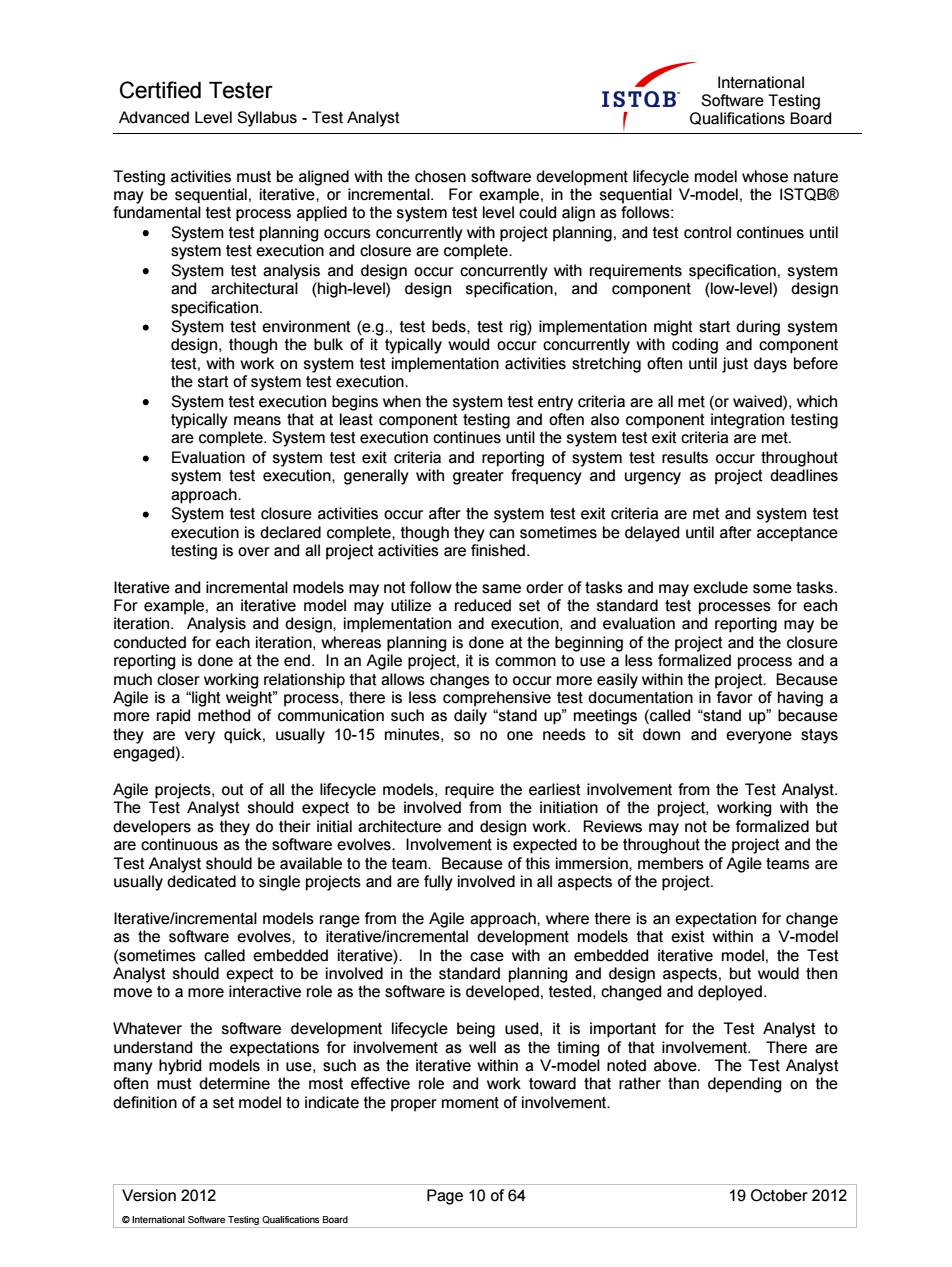正在加载图片...

Certified Tester ISTQB Advanced Level Syllabus-Test Analyst Qualifications Board ned with the enhosearsearmpe e fundamentai test process applied to the system test level could align as follows: System test plann with project planning.and test control continues until System test analysis and design occur concu ently with requirements specification.system and architectural (high-level)design specification,and component(low-level)design 10n h work on system test implementation activities stretching often until just days before are complete.System test execution continues until the system test exit criteria are met. a with and 0 etnea8hoe approach System test closure activities ater the system test exit aremet and system test are finished. r acceptance rermeatalmodesmayno may exclude iteration.Analysis and design.implementation and execution.and evaluation and reporting may be nereas planning is d lone at the eginning of the project and the cl osure uch closer cha asily withinh Agile is a "igh veight"process.the ere is less co nsive test docur nen aton in favor of having a more rapid suc s aily up quick. 0-15 minutes A9aepeetoaghe th developers as the do their initial architecture and de ign work. Reviews n nav no be for usually dedicated to single projects and are fully involved in all aspects of the project. aeraheoRemeneaoeseaeetemchenelaereopneherRoteeaneecaionohp3S edded iterative). terac s the and depl t for the Test A ctive role and vard that rather than depending on the Version 2012 Page 10 of 64 19 October 2012Certified Tester Advanced Level Syllabus - Test Analyst International Software Testing Qualifications Board Version 2012 Page 10 of 64 19 October 2012 © International Software Testing Qualifications Board Testing activities must be aligned with the chosen software development lifecycle model whose nature may be sequential, iterative, or incremental. For example, in the sequential V-model, the ISTQB® fundamental test process applied to the system test level could align as follows: System test planning occurs concurrently with project planning, and test control continues until system test execution and closure are complete. System test analysis and design occur concurrently with requirements specification, system and architectural (high-level) design specification, and component (low-level) design specification. System test environment (e.g., test beds, test rig) implementation might start during system design, though the bulk of it typically would occur concurrently with coding and component test, with work on system test implementation activities stretching often until just days before the start of system test execution. System test execution begins when the system test entry criteria are all met (or waived), which typically means that at least component testing and often also component integration testing are complete. System test execution continues until the system test exit criteria are met. Evaluation of system test exit criteria and reporting of system test results occur throughout system test execution, generally with greater frequency and urgency as project deadlines approach. System test closure activities occur after the system test exit criteria are met and system test execution is declared complete, though they can sometimes be delayed until after acceptance testing is over and all project activities are finished. Iterative and incremental models may not follow the same order of tasks and may exclude some tasks. For example, an iterative model may utilize a reduced set of the standard test processes for each iteration. Analysis and design, implementation and execution, and evaluation and reporting may be conducted for each iteration, whereas planning is done at the beginning of the project and the closure reporting is done at the end. In an Agile project, it is common to use a less formalized process and a much closer working relationship that allows changes to occur more easily within the project. Because Agile is a “light weight” process, there is less comprehensive test documentation in favor of having a more rapid method of communication such as daily “stand up” meetings (called “stand up” because they are very quick, usually 10-15 minutes, so no one needs to sit down and everyone stays engaged). Agile projects, out of all the lifecycle models, require the earliest involvement from the Test Analyst. The Test Analyst should expect to be involved from the initiation of the project, working with the developers as they do their initial architecture and design work. Reviews may not be formalized but are continuous as the software evolves. Involvement is expected to be throughout the project and the Test Analyst should be available to the team. Because of this immersion, members of Agile teams are usually dedicated to single projects and are fully involved in all aspects of the project. Iterative/incremental models range from the Agile approach, where there is an expectation for change as the software evolves, to iterative/incremental development models that exist within a V-model (sometimes called embedded iterative). In the case with an embedded iterative model, the Test Analyst should expect to be involved in the standard planning and design aspects, but would then move to a more interactive role as the software is developed, tested, changed and deployed. Whatever the software development lifecycle being used, it is important for the Test Analyst to understand the expectations for involvement as well as the timing of that involvement. There are many hybrid models in use, such as the iterative within a V-model noted above. The Test Analyst often must determine the most effective role and work toward that rather than depending on the definition of a set model to indicate the proper moment of involvement